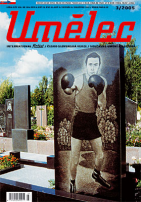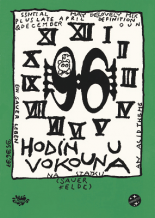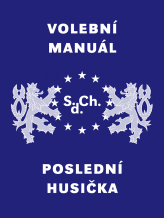| Umělec 2005/3 >> Codes of the Middle Class | Просмотр всех номеров | ||||||||||||
|
|||||||||||||
Codes of the Middle ClassUmělec 2005/301.03.2005 Jiří Ptáček | info | en cs de es |
|||||||||||||
|
ZVON: The 5th Biennial of Young Art
Dům U Kamenného Zvonu, (House at the Stone Bell) , Prague 4. 14. – 6. 5. 2005 The Prague Biennial of Young Art at the House of the Stone Bell (Zvon) has its own unique place in the Czech Republic, an established niche with a specific radius of action. That means: it has taken place in the prestigious exhibition hall in the middle of the Czech capital five times within the last nine years; the curator of each has always demonstrated their understanding of up-to-date art; using selected representatives of the young generation from the Czech Republic. This year was no different, so there seems to be no space for surprises. Nevertheless, the curator of the fifth biennial, Karel Císař, managed to reorient the gyroscope, for at least one reason. Curator Karel Císař is always on the defensive himself when he is referred to as an “art person.” It isn’t clear whether he is dead serious about it or if he just wants to maintain distance from public experts. In any case, this curator does work with art and its theory—as the author of articles and editor of books. Moreover, his resume mentions participation at art conferences and last year he organized a successful exhibition in Berlin’s K&S gallery and its follow-up in Prague’s now defunct Home gallery. This year, he was co-organizer of one of the Prague Biennial 2 expositions. In the Czech Republic he ranks highly among the most active “people.” It could even be said that he is an ideal prototype of a new wave of personalities in the cultural milieu. A philosopher who deals with art in an off-hand manner, his attentions are directed abroad; domestic quarrels leave him cold. He is young, with excellent organizational skills, and he is communicative. Because there are precious few like him in the Czech Republic, the invitation of the Prague’s city gallery met with a thoroughly positive response. During the preparations, however, the effort with which Císař illuminated his intentions seemed foreboding. He selected no topic and made no declaration. If he wanted to speak about something, it would be about the sensitivity necessary to work with today’s art, and about the ongoing search for configuration. Begging to be asked was whether he was harboring some unexpected vision or merely trying to hide that he was not entirely sure about his intentions. It was only at the event’s opening night that, for a very unique reason, it was clear that it was the former after all. Two Messages Two separate messages were presented to the public. One was directed to the art scene and the other was towards an audience that is by-and-large uninformed about changes within Czech visual culture. Were we to focus only on the former, we would find out that neither expectations of new names nor anticipation for any new hierarchy on the art scene were met. Most of the artists presented their standard output and nobody offered any new strategies. Moreover, those familiar with Czech artists over a longer period of time could correctly state that all the exhibitors “have been heard of” and say that Císař merely worked with what had been explored by more radically-oriented Czech activities (like Prague’s Tranzit, Display, A.M. 180 or Brno’s Eskort). Císař could be even accused of trying to make his work easier by selecting prefabricated goods. Nevertheless, this curator’s approach deserves more discussion. Searching for unknown or overlooked personalities in the Czech Republic’s rather small scene could result in a rapid relaxation of standards. People persistently perturbed by the eclecticism presented could be persuaded by Císařîs courage in taking steps towards communicating with the lay public. He succeeded in proposing conditions according to which the young generation could be best brought to the public’s attention, risking that the discerning public might sense its freedom being limited in the grip of a vise. Dealing with Art Císař’s initial important step was to work with the reputation of an arrangeur without hesitation. One of the Prague city galleries, The House at the Stone Bell, is known for its expositions of modern and contemporary art from the Czech Republic and abroad. Set in the tourist center of Prague, the gallery receives visits from both the erudite experts and the madding crowd—from Italian newlyweds on vacation to school excursions from the country. It would be nothing new to invite twenty young artists to such a place, drawing them from the periphery to a visible public location. That is indeed the purpose of the Zvon shows. Císařîs primacy lies in the manner he allocated the art works of “his” artists to meet the expectations of inexperienced visitors—by the choice of artists and works but also by the arrangement of the works in the gallery. First, he did not choose any traditionaly provocative topic. Sex, violence, psychological trauma, social dissonance or political action did not appear in the exhibition. To be sure, there are encounters with the happenings of Rafani, Zhotovny and the shocking dummy bombs of Zdeněk Porcal and Lukáš Hájek, but these were only mediated through a small number of photocopies from daily newspapers. It seemed a bit as if they touched the media world only superficially (In reality there was a wave of reactions: the Rafani group was mentioned in the Czech newspapers, web forums and in the Czech Railways magazine within one month). Císař wanted to balance Zvon differently. By eliminating provocative topics he allowed more intimate and scrutinizing techniques to resound. Three Groups Although perhaps an overly simplistic reduction, the artists presented fit into three basic categories. The first one includes those who strive for a more active relationship of humankind with environments. The second one includes artists who enliven the relationship of art to tradition. The members of the last group explored the role of artist as “another” narrator of a story: Kateřina Šedá walked with two cameras on her head and recorded what normally stays out of sight; Jesper Alvaer asked suburban residents for their opinions about their gardens or Evžen Šimera with geometric objects offered street-style obstacles to skate-boarders. Matěj Smetana made his point about the institution and tradition of art by photographing scribbles in the otherwise perfect design of the works of Donald Judd, Sol LeWitt and John McCracken. Jiří Skála, for a change, collaborated on reducing the Macintosh standard Helvetica font into a series of dots derived from the square area of the characters on a computer keyboard; the result was a large black-and-white, “minimalist” poster that visitors could take home. Of course with many artists one level tended to blend into another (Jan Šerých painted the pattern of the carpet from Stanley Kubrick’s The Shining on the wall, the yellow minimalist circles of Patricia Fex were actually large photographs of the sun). Yet there was still a third group of “story narrators.” Included in this was the “Brno circle” represented by Petr Strouhal, Matěj Smetana, Magdalena Hrubá, and the duo of Filip Cenek and Jiří Havlíček. Their animations (and one video) appeared in one hall facing each other, but appeared to come from a single source. A little further on they were surprisingly joined even by Josef Bolf. He connected an audio recording in which he, in an unschooled voice, read out his own unreal story to a wall accompanied by his sketches, deliriously drawn comic portraits. All these artists are united by a desire to join fictional worlds, a use of overlapping self-referential elements, poetic hyperbole and interventions into standard narrative schemes. Another feature of configuration was the way that the blocks of work focused on environments or the stereotypical interpretation of reality, permeated the blocks in which the driving force was the shift of well-established formal schemes (an example was Eva Koťátkováîs room and Jakub Hošekîs paintings). This sequencing of the installation enabled Císař to lessen the differences separating individual artistic approaches and to create space for mutual influence in which authorship became subordinate to the space between the exhibited artifacts. Nobody said that individual needs to be represented in an exhaustive way. And Císař used this to the utmost. He smoothed the edges of individual utterances and presented us with art as a brightly wrapped package of mutually intertwined and non-conflicting pieces of information. He seemed to urge the visitor to think about art that does not malign and does not try to refute initial impressions of friendly affinity and shared focus on everyday life. And with no hesitation, he defended art for its decorative value. He mediated values of prudent, non-conflicting artistic production, the result of which is mainly the visually standard artifact. The impudent, rigorous, engaged, complicated or less spectacular art had to stay in the studios. As if one hall after another explained: “We are like you, we just say it in different words.” Perhaps We Do Not Understand Each Other, So We Won’t Speak about It If cultural life were satisfactory, then this Zvon exhibition would probably be considered as little more than a clear curatorial comment on how there really is some young art, the work of straightforward and skilled artists interested in the life of the middle class. In a situation where young art finds arguments to defend its interest in experiments with difficulties, this helps in a way. Nevertheless, one might ask if the artists identify with this message, and if they were aware of what configuration was awaiting them. But the question remains whether a situation where complex exhibitions of young art in representative cultural institutions rarely take place and the public is understandably hardly concerned, Zvon was not particularly generous to the neo-capitalistic and consumer tendencies Czech society. But nobody asked these questions: in the Czech Republic it usually suffices that something can be realized. As a step to another kind of communication with the public, the Zvon show was not uninteresting. It provided material for impassioned discussions about what artists expect from society, what they treasure about it and what they refuse from it. In addition, the show addressed what is expected from organized culture. It is regrettable that reactions to these stimuli were few and far between, as among the critical art community there was a fear that Zvon was a Pandora’s box, unadvisable to open. Maybe the artists from this exhibition do not even understand each other in relation to these questions; perhaps all that “insider” solidarity about which we still reassure ourselves, is only a laboriously maintained myth.
01.03.2005
Рекомендуемые статьи
|
|||||||||||||
|
04.02.2020 10:17
Letošní 50. ročník Art Basel přilákal celkem 93 000 návštěvníků a sběratelů z 80 zemí světa. 290 prémiových galerií představilo umělecká díla od počátku 20. století až po současnost. Hlavní sektor přehlídky, tradičně v prvním patře výstavního prostoru, představil 232 předních galerií z celého světa nabízející umění nejvyšší kvality. Veletrh ukázal vzestupný trend prodeje prostřednictvím galerií jak soukromým sbírkám, tak i institucím. Kromě hlavního veletrhu stály za návštěvu i ty přidružené: Volta, Liste a Photo Basel, k tomu doprovodné programy a výstavy v místních institucích, které kvalitou daleko přesahují hranice města tj. Kunsthalle Basel, Kunstmuseum, Tinguely muzeum nebo Fondation Beyeler.
|





































 New book by I.M.Jirous in English at our online bookshop.
New book by I.M.Jirous in English at our online bookshop.
Комментарии
Статья не была прокомментированаДобавить новый комментарий